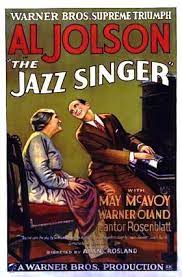On October 6, 1927, a groundbreaking film was released that would forever change the course of cinema and popular culture. "The Jazz Singer," directed by Alan Crosland, marked the first feature-length motion picture with synchronized dialogue sequences, revolutionizing the film industry and introducing the era of "talkies." "The Jazz Singer" starred Al Jolson, a renowned entertainer known for his dynamic singing and charismatic stage presence. The film tells the story of Jakie Rabinowitz, a young Jewish man who defies his traditional family's wishes to become a jazz singer. The film blends elements of drama, music, and comedy, capturing the spirit and energy of the Roaring Twenties. What made "The Jazz Singer" truly groundbreaking was its use of synchronized sound. While previous films had experimented with synchronized sound for short segments, "The Jazz Singer" was the first to incorporate sound throughout the entire movie. This was made possible by the Vitaphone system, developed by Warner Bros., which synchronized sound recordings with the film's visuals. The inclusion of synchronized dialogue and musical performances in "The Jazz Singer" captured the imagination of audiences and brought a new level of realism and engagement to the cinematic experience. The film's release marked a turning point in the industry, leading to the eventual demise of silent films and the rapid adoption of sound technology. "The Jazz Singer" was a commercial success, drawing large audiences and generating significant buzz. Its success prompted other studios to follow suit and invest in sound technology, leading to a wave of sound films in the late 1920s and early 1930s. The transition from silent films to sound films was not without challenges, as filmmakers had to adapt to new techniques and equipment, but it ultimately revolutionized the industry and expanded the possibilities of storytelling on the big screen. Beyond its technical achievements, "The Jazz Singer" also resonated with audiences on a cultural level. The film tackled themes of identity, tradition, and the pursuit of one's dreams, which struck a chord with viewers. Al Jolson's electrifying musical performances, including his rendition of the iconic song "My Mammy," captivated audiences and helped popularize jazz music in mainstream culture. However, it is important to acknowledge that "The Jazz Singer" also faced criticism for its portrayal of racial stereotypes. Al Jolson's use of blackface during some scenes, though common in the entertainment industry at the time, is now seen as highly problematic and offensive. While the film's technical achievements were groundbreaking, its racial insensitivity is a reminder of the need for progress and cultural understanding. Despite its flaws, "The Jazz Singer" remains a significant milestone in cinematic history. It paved the way for the development of sound technology in film and set the stage for the golden age of Hollywood. Its impact on popular culture cannot be overstated, as it ushered in a new era of storytelling and forever changed the way we experience movies. October 6, 1927, will always be remembered as the day "The Jazz Singer" premiered, forever altering the course of cinema. Its introduction of synchronized sound transformed the film industry and opened up new possibilities for storytelling. While the film's racial depictions are problematic, its technical achievements and cultural impact cannot be denied, solidifying its place in the annals of film history.
6 Oct, 1927 U.S.A. “The Jazz Singer”
